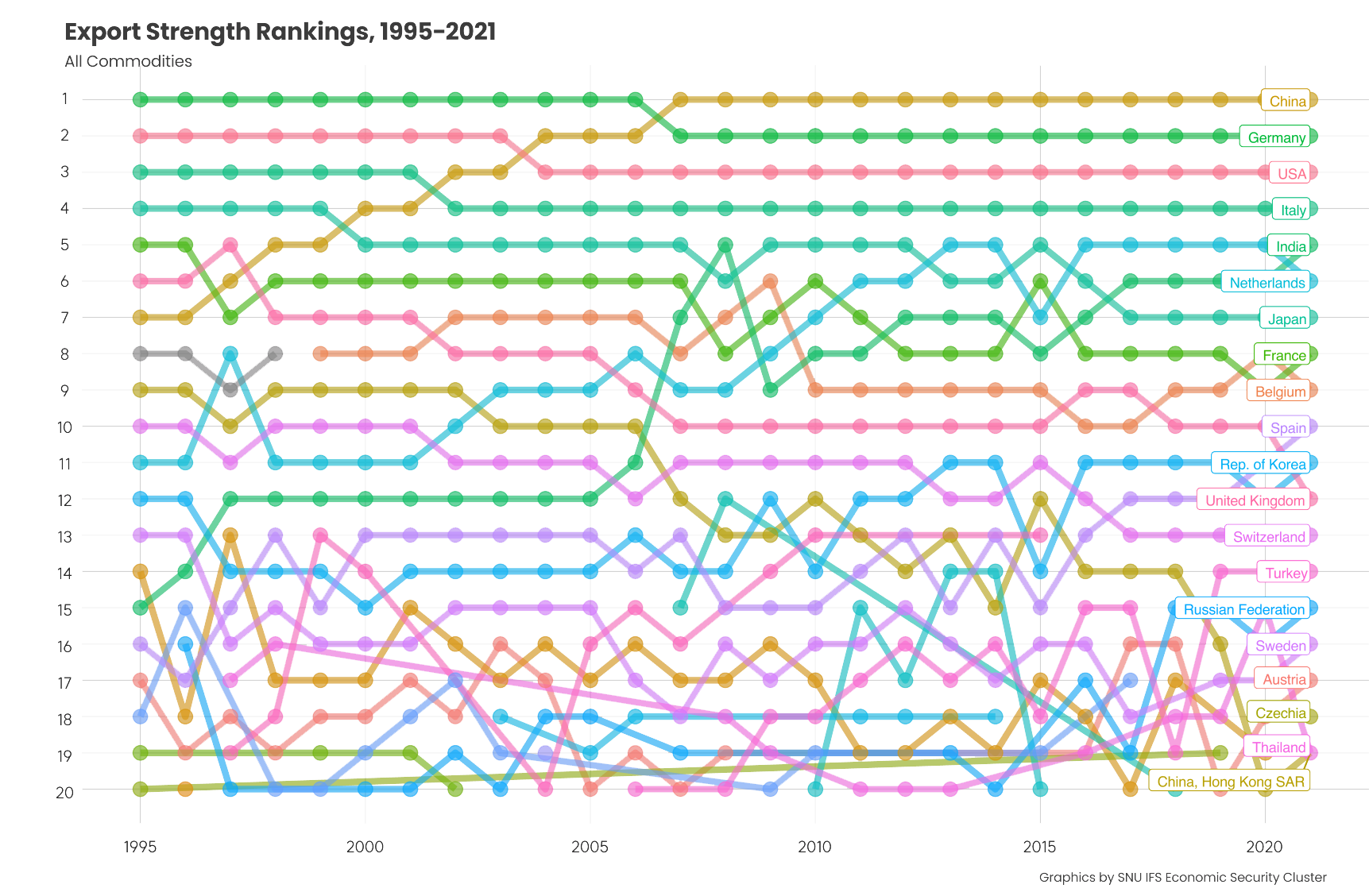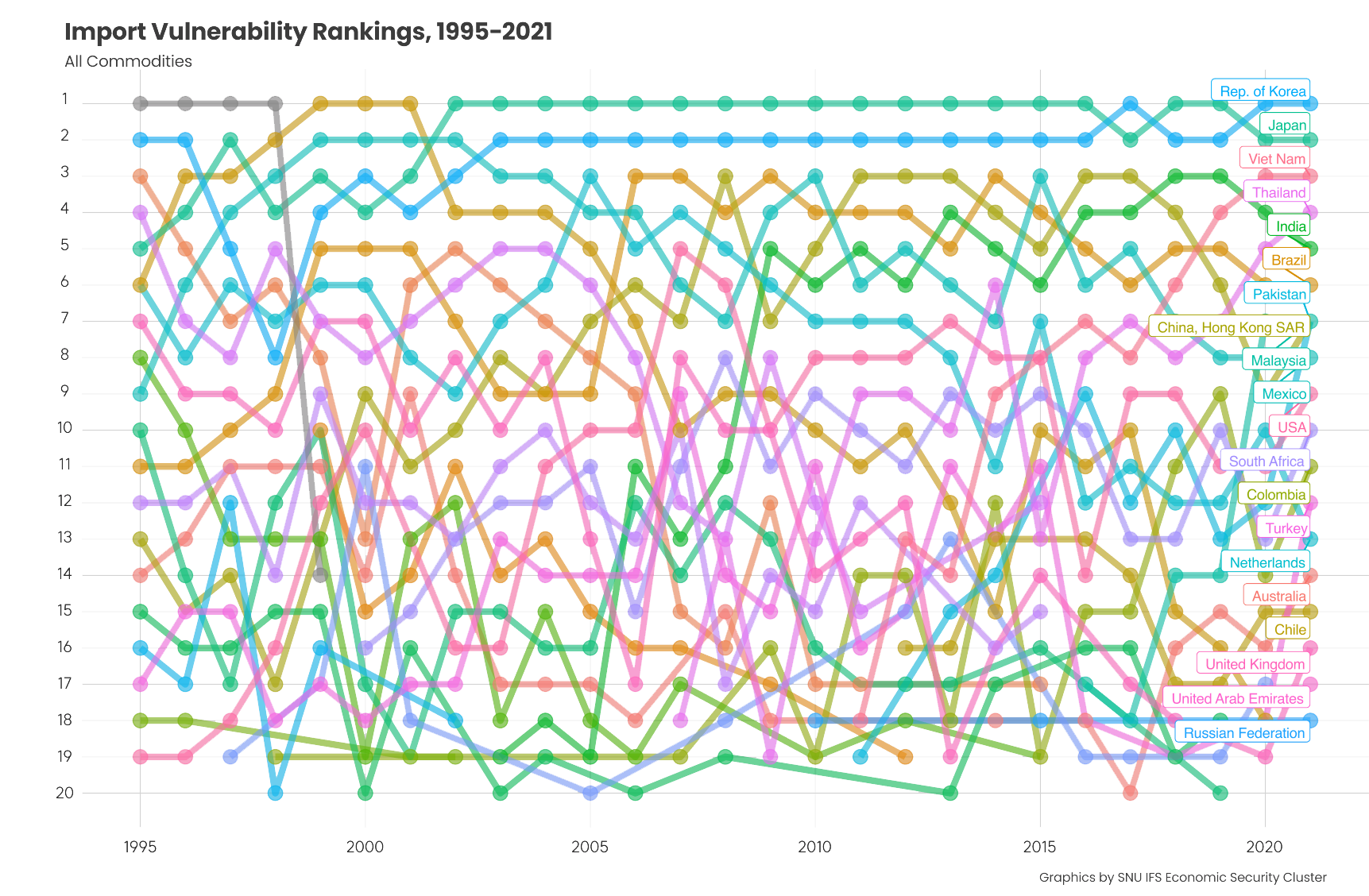경제안보 지수 개발 배경
Development Background of the Economic Security Index
경제안보는 경제관계 뿐만 아니라 안보 및 외교관계까지 결정하는 중요한
국제정치 키워드가 됐다. 국가 미래전략 구상이라는 중차대한 목표를 위해
출범한 서울대학교 미래전략원은 경제안보 클러스터를 구성하여
경제안보에서의 국가 미래전략을 연구하고 있다.
경제안보 클러스터는 경제안보전략 구상을 위해 국가 간 경제관계를 정확히
분석하고, 경제안보 관점에서 정확하게 요약하는 것이 중요 기초
작업이라고 판단하였다. 이에 1차년도 목표를 경제안보의 지도를 보여줄 수
있는 객관적 지수 개발로 설정했다.
Economic security has emerged as a pivotal concept in international politics, influencing not only economic relations but also security and diplomatic ties. The Seoul National University Institute for Future Strategy has formed an Economic Security Cluster to research future strategies in economic security.
The Economic Security Cluster determined that accurately analyzing inter-state economic relationships and summarizing them from an economic security perspective constitutes essential groundwork for developing economic security strategies and facilitating international cooperation. Consequently, the first-year objective was set to develop an objective index capable of mapping economic security landscapes.
경제안보는 실체가 명료하지 않은 복잡하고 모호한 개념이며, 포괄하는
영역이 무역, 투자, 자원, 정책, 기술을 망라하여 매우 방대하다. 이에
경제안보 클러스터는 경제안보의 다양한 영역 중 객관적이고 신뢰할 만한
자료가 체계적으로 구축된 국제 무역자료를 활용하여 대한민국이 처한
경제 안보의 현실을 분석했다.
우리는 무역을 통해 나타나는 경제안보에서의 국가 간 관계의 특징을 공급망 지배력(supply chain dominance)로 정의하고 이를 구성하는 두 가지 요소를 수출권력(export strength)과 수입취약성(import vulnerability)이라는 개념으로 정의한다. 권력과 취약성은 다음과 같이 계산했다.
우리는 무역을 통해 나타나는 경제안보에서의 국가 간 관계의 특징을 공급망 지배력(supply chain dominance)로 정의하고 이를 구성하는 두 가지 요소를 수출권력(export strength)과 수입취약성(import vulnerability)이라는 개념으로 정의한다. 권력과 취약성은 다음과 같이 계산했다.
Methodology and Development Process
Economic security is a complex and ambiguous concept lacking clear definition, encompassing vast domains including trade, investment, resources, policy, and technology. The Economic Security Cluster focused on analyzing the potential geopolitical challenges countries might face in global supply chains. We conceptualize the characteristics of interstate relationships in global supply chains as “supply chain dominance,” which comprises two key components:
◆ Export Strength: Measuring a nation’s product-level power in export relationships
◆ Import Vulnerability: Assessing a nation’s product-level susceptibility in import dependencies
These metrics of power and vulnerability are systematically calculated using HS 6 product-level bilateral trade data, providing quantitative insights into countries’ relative power positions in global supply chains.
This framework enables objective assessment of economic security relationships and provides policymakers with data-driven insights for strategic decision-making in an increasingly complex global economic landscape.
Export
Strength
Strength
원하지 않는 상대 국가의 변화를 막거나 원하는 방향으로 상대 국가의
변화를 유도할 수 있는 잠재력
The Potential to Either Prevent Undesired Changes or Guide Desired Changes in Target Nations
The Potential to Either Prevent Undesired Changes or Guide Desired Changes in Target Nations
HS코드 6자리 기준으로 상품 복잡성 지수(product complexity index)가
중간값 이상인 상품의 생산에서 상당한 비중을 차지하고 있으면서 그
상품을 특정 국가에게 집중적으로 수출하는 경우 해당 상품에서 해당
국가에 대한 수출권력이 존재한다고 간주한다.
Export strength is determined to exist when a nation meets two critical criteria in relation to products with above-median Product Complexity Index (PCI) values at the HS 6-digit code level:
1. Maintains substantial production capacity for these products
2. Demonstrates concentrated export patterns to specific nations
This metric captures the potential leverage that can be exercised through strategic control of sophisticated export relationships.
Import
Vulnerability
Vulnerability
권력에 노출된 정도
Degree of Exposure to External Economic Power
Degree of Exposure to External Economic Power
상품 복잡성 지수가 중간값 이상인 상품 수입에서 특정 국가에 대한
의존도가 매우 높고 그 수입국가가 해당 상품의 전 세계 수출에서
차지하는 비중 또한 높은 경우 해당 국가에 대한 수입취약성이
존재한다고 간주한다.
Import vulnerability is established when two key conditions are met for products with above-median Product Complexity Index (PCI) values:
1. High dependency on specific nations for imports
2. The exporting nation commands a significant share of global exports for these products
This dual-criteria framework measures the extent to which a nation is susceptible to external economic pressure through critical import dependencies.
1. High dependency on specific nations for imports
2. The exporting nation commands a significant share of global exports for these products
This dual-criteria framework measures the extent to which a nation is susceptible to external economic pressure through critical import dependencies.
The methodology employs the Product Complexity Index (PCI) as a key filter (containing only the above median PCI products), focusing on sophisticated products that typically represent higher strategic value in global supply chains. This approach enables identification of asymmetric dependencies and potential leverage points in international trade relationships, providing crucial insights for economic security strategy formulation.
The combination of these metrics creates a comprehensive framework for understanding both offensive and defensive positions in economic security relationships, particularly in high-value, complex product categories that often represent critical nodes in global supply chains.
The combination of these metrics creates a comprehensive framework for understanding both offensive and defensive positions in economic security relationships, particularly in high-value, complex product categories that often represent critical nodes in global supply chains.
Main Insight


함의 및 활용
Implications and Applications
상품, 연도, 양자 관계 기반의 수출권력과 수입취약성 지수가 계산되면, 이
지수를 기반으로 국가 간 관계의 특징을 요약할 수 있다.
구체적 지수로 측정된 양자관계 특징
특히, 네트워크로 투사된 수출 권력과 수입 취약성 구조는
대한민국이 처한 경제안보 현실을 세밀하게 분석하는 도구가
되며 네트워크의 시간적 변화, 지역적 연결성 특징, 중심성 및 요충지,
클러스터링 구조 분석은 경제 안보 네트워크의 위상학적 구조 분석을
가능케 한다.
경제안보지수는 국제무역에서 대한민국이 직면한 경제안보 현실을 정확히 파악하고 전 세계 국가들의 경제안보 위치를 파악하는 데에 일차적으로 큰 도움이 될 것이다. 특히, 경제안보에 대한 정부정책 수립, 기업의 대외전략 수립, 연구자들의 경제안보에 대한 분석을 도울 수 있고 시민들의 경제안보 현실에 대한 이해 수준을 높일 수 있다.
이렇게 정리된 경제안보 지수는 다양한 방식으로 활용될 수 있다. 먼저 무역관계에서 급소(chokepoint)나 전략적 자율성, 공급망, 회복력과 같은 핵심개념을 이해하는 데 도움을 줄 수 있다. 또한 상품, 국가, 양자관계, 네트워크 측면에서 경제안보의 지도를 효과적으로 그릴 수 있어서 미시적, 중시적, 거시적 분석이 가능하다. 마지막으로 수출권력과 수입취약성의 기준을 사용자의 분석 목적에 맞게 조정할 수 있다.
경제안보지수는 국제무역에서 대한민국이 직면한 경제안보 현실을 정확히 파악하고 전 세계 국가들의 경제안보 위치를 파악하는 데에 일차적으로 큰 도움이 될 것이다. 특히, 경제안보에 대한 정부정책 수립, 기업의 대외전략 수립, 연구자들의 경제안보에 대한 분석을 도울 수 있고 시민들의 경제안보 현실에 대한 이해 수준을 높일 수 있다.
이렇게 정리된 경제안보 지수는 다양한 방식으로 활용될 수 있다. 먼저 무역관계에서 급소(chokepoint)나 전략적 자율성, 공급망, 회복력과 같은 핵심개념을 이해하는 데 도움을 줄 수 있다. 또한 상품, 국가, 양자관계, 네트워크 측면에서 경제안보의 지도를 효과적으로 그릴 수 있어서 미시적, 중시적, 거시적 분석이 가능하다. 마지막으로 수출권력과 수입취약성의 기준을 사용자의 분석 목적에 맞게 조정할 수 있다.
The computation of export strength and import vulnerability indices based on products, years, and bilateral relationships enables a comprehensive characterization of international economic relationships.
Bilateral Relationships Measured Through Concrete Indices
The projection of export strength and import vulnerability structures into network frameworks provides several key analytical advantages:
1. Detailed Analysis of Countries’ Economic Security Reality
- Network temporal evolution analysis
- Regional connectivity patterns
- Centrality and strategic position identification
- Clustering structure examination
- Network temporal evolution analysis
- Regional connectivity patterns
- Centrality and strategic position identification
- Clustering structure examination
2. Topological Network Analysis
Enables understanding of:
- Network structural changes over time
- Strategic chokepoints
- System vulnerabilities
- Resilience patterns
Enables understanding of:
- Network structural changes over time
- Strategic chokepoints
- System vulnerabilities
- Resilience patterns
Primary Applications
The Economic Security Index serves multiple strategic purposes:
1. Precise Assessment
- Accurately maps countries’ position in global supply chains
- Provides global economic security positioning of nations
- Accurately maps countries’ position in global supply chains
- Provides global economic security positioning of nations
2. Strategic Planning Support
- Government policy formulation
- Corporate economic strategy development
- Academic research facilitation
- Public understanding enhancement
- Government policy formulation
- Corporate economic strategy development
- Academic research facilitation
- Public understanding enhancement
Practical Utilization
The index offers versatile analytical capabilities:
1. Core Concept Analysis
- Trade chokepoints
- Strategic autonomy
- Supply chain dynamics
- System resilience
- Trade chokepoints
- Strategic autonomy
- Supply chain dynamics
- System resilience
2. Multi-level Analysis
- Micro-level: Individual products and bilateral relationships
- Meso-level: Sectoral and regional patterns
- Macro-level: Global network structures
- Micro-level: Individual products and bilateral relationships
- Meso-level: Sectoral and regional patterns
- Macro-level: Global network structures
3. Customization Potential
- Adjustable export strength and import vulnerability criteria
- Flexible application for specific analytical needs
- Adaptable framework for various strategic objectives
- Adjustable export strength and import vulnerability criteria
- Flexible application for specific analytical needs
- Adaptable framework for various strategic objectives
This comprehensive analytical tool provides stakeholders with quantitative insights for evidence-based decision-making in economic security strategy formulation.
세계경제포럼(DavosForum) 보고서는 다음에서 다운받으실 수 있습니다.